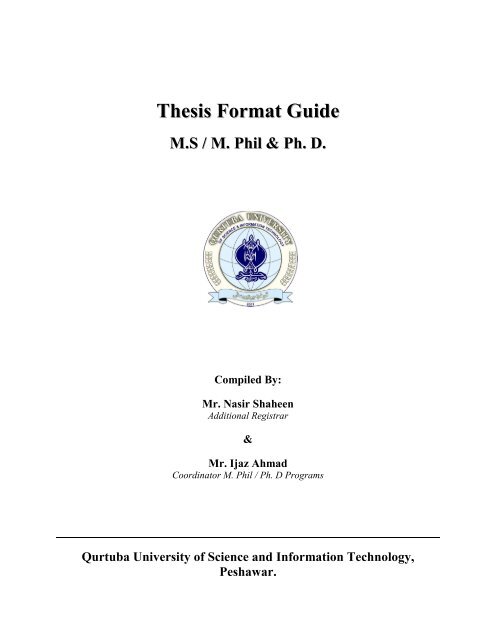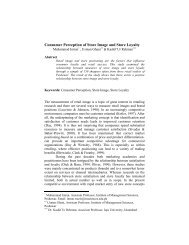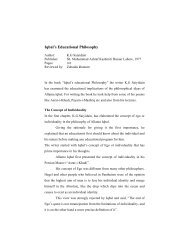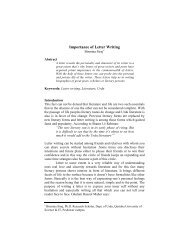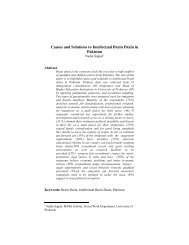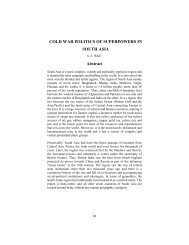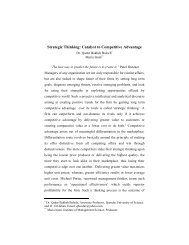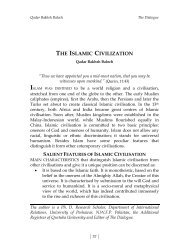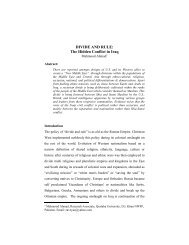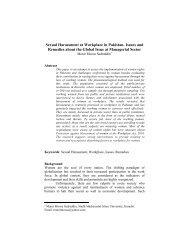Thesis Format Guide - Qurtuba University of Science & Information ...
Thesis Format Guide - Qurtuba University of Science & Information ...
Thesis Format Guide - Qurtuba University of Science & Information ...
You also want an ePaper? Increase the reach of your titles
YUMPU automatically turns print PDFs into web optimized ePapers that Google loves.
<strong>Thesis</strong> <strong>Format</strong> <strong>Guide</strong><br />
M.S / M. Phil & Ph. D.<br />
Compiled By:<br />
Mr. Nasir Shaheen<br />
Additional Registrar<br />
&<br />
Mr. Ijaz Ahmad<br />
Coordinator M. Phil / Ph. D Programs<br />
<strong>Qurtuba</strong> <strong>University</strong> <strong>of</strong> <strong>Science</strong> and <strong>Information</strong> Technology,<br />
Peshawar.
Table <strong>of</strong> Contents<br />
Preface …………………………….………………………………………................ 1<br />
1. Preliminary Section:<br />
1.1 Title Page………………………………………………………………….…….... 2<br />
1.2 Dedication and Acknowledgements………..……………….……………......…... 2<br />
1.3 Preliminary Documents ……………………………...……………….................. 2<br />
1.4 Table <strong>of</strong> Contents………………………………………………….………….…. 3<br />
1.5 Abstract ………………………………………………………………………...… 2<br />
2. Body <strong>of</strong> <strong>Thesis</strong>:<br />
2.1 Introduction………………………………………………………….……... 4<br />
2.2 Literature Review………………………………………………….…….…. 3<br />
2.3 Methodology……………………………………………………….….…...... 4<br />
2.4 Analysis / Data Analysis……………………………………………..….…...6<br />
2.5 Findings & Recommendation ………………………………………….….. 7<br />
2.6 References & Bibliography.…………… …………………………...….….. 8<br />
3 Referencing & Citation - For Social <strong>Science</strong>s<br />
3.1 Handling Quotes In the Text ......................................................................9<br />
3.2 In-Text Citation..............................................................................................9<br />
3.3 Reference List: Books ..................................................................................10<br />
3.4 Reference List: Articles............................................................................... 11<br />
3.5 Reference List: Electronic Sources ............................................................. 12<br />
3.6 Reference List: Media .................................................................................... 13<br />
3.7 Reference List: General Reference Databases ............................ ........... 13<br />
3.8 Reference List: General Subject Databases ............................................. 14<br />
3.9 Reference List: Current/Controversial Issues ....................................... 15<br />
3.10 Reference List: Subject-Specific Databases ............................................. 16<br />
ii
4 Referencing & Citation For Literature and Linguistics<br />
4.1 Books .......................................................................................................... 18<br />
4.2 Journals and Newsapapers …………………………………………… 21<br />
4.3 Electronic Publications …………………………………………………. 22<br />
5 <strong>Format</strong>ting:<br />
5.1 Pages Size………………………………………………………………… 24<br />
5.2 Page Setup……………………………………………………………….. 24<br />
5.3 Font ……………………………………………………………………… 24<br />
5.4 Font Size…………………………………………………………………. 24<br />
5.5 Headings and Sub Headings………………………………………….. 24<br />
5.6 Paragraph Setting………………………………………………………. 24<br />
5.7 Number <strong>of</strong> Copies………………………………………………………. 25<br />
5.8 Binding…………………………………………………………………... 25<br />
5.9 S<strong>of</strong>t Copy <strong>of</strong> <strong>Thesis</strong>……………………………………………………… 25<br />
SAMPLE………………………………………………………………………………….. 26<br />
iii
Page left blank intentionally<br />
4
Preface<br />
The thesis or dissertation is the single most important element <strong>of</strong> a research degree. It<br />
is a test <strong>of</strong> the student’s ability to undertake and complete a sustained piece <strong>of</strong> independent<br />
research and analysis, and to write up that research in a coherent form according to the<br />
rules and conventions <strong>of</strong> the academic community.<br />
As a rule, the main components <strong>of</strong> a research study are nearly the same in all<br />
disciplines throughout the world. Though, various styles <strong>of</strong> referencing and citation are<br />
used by the researchers in their research work i.e. APA, MLA, Harvard, Chicago, Turabian<br />
etc. Nonetheless, every established university develops its own customized format for its<br />
students’ facilitation in presentation <strong>of</strong> research proposals and theses to make a significant<br />
contribution in successful completion <strong>of</strong> M. S / M. Phil and Ph. D. research.<br />
The purpose <strong>of</strong> this document is to outline the standard requirements and guidelines<br />
that an M. S /M. Phil / PhD <strong>Thesis</strong> should adhere to in the area <strong>of</strong> organization and writing<br />
skills in order to be accepted at <strong>Qurtuba</strong> <strong>University</strong> <strong>of</strong> <strong>Science</strong> and <strong>Information</strong> Technology.<br />
1
1 - Preliminary Section<br />
1.1 Title Page:<br />
The title page <strong>of</strong> the research thesis should include title <strong>of</strong> the research project, name<br />
<strong>of</strong> the student (with degree name), full title <strong>of</strong> the university and date (month and<br />
year) <strong>of</strong> submission.<br />
(See Sample)<br />
1.2 Approval Certificate:<br />
Approval certificate should be attached after title page:<br />
(See sample)<br />
1.3 Dedication and / or Acknowledgements: (Optional)<br />
These pages are optional.<br />
numerals.<br />
If included, they must be numbered with Roman<br />
1.4 Table <strong>of</strong> Contents:<br />
The Table <strong>of</strong> Contents must be placed before the text and any lists <strong>of</strong> tables,<br />
figures, etc. It consists <strong>of</strong> section titles, chapter titles, and as many or few<br />
subheadings as the author feels are necessary. The section and chapter titles listed on<br />
the Table <strong>of</strong> Contents must exactly match the titles as they appear within the text.<br />
The page numbers listed on the Table <strong>of</strong> Contents must correlate with the beginning<br />
<strong>of</strong> each section or chapter.<br />
Table <strong>of</strong> Contents entries are generally double-spaced. However, chapter titles and<br />
subheadings, when more than one line long, should be indented at the second line<br />
and single-spaced.<br />
2
It is acceptable to have a minimal Table <strong>of</strong> Contents, consisting only <strong>of</strong> the<br />
sections Text, Bibliography, and Vita with their respective page numbers if the<br />
text itself has no divisible chapters or major sections.<br />
No material preceding the table <strong>of</strong> contents should be enlisted in it i.e. Preliminary<br />
Documents, Dedication etc,.<br />
Note: All the pages <strong>of</strong> preliminary section should be without page numbers.<br />
1.5 Abstract:<br />
A short abstract is required say <strong>of</strong> a page or two. It is to be a compact description <strong>of</strong><br />
the research work.<br />
3
2 - Body <strong>of</strong> Research Proposal / Synopsis<br />
In general the main body <strong>of</strong> the research thesis includes the following chapters:<br />
Chapter 01 – Introduction<br />
Chapter 02 – Literature Review<br />
Chapter 03 – Methodology<br />
Chapter 04 – Data Analysis and / or Discussion<br />
Chapter 05 – Results and Recommendations<br />
However, some scholars may divide their thesis in sections with the above titles and further<br />
divide each section into relevant chapters and present each subsection as a separate chapter.<br />
In that case the number <strong>of</strong> chapters may increase.<br />
2.1 Introduction: (Chapter 1)<br />
It should provide a brief description with a view to introducing the area <strong>of</strong> research<br />
and provide background information relating to the social / political / historical /<br />
educational / organizational (etc) context <strong>of</strong> the study. This chapter may include the<br />
following subsections:<br />
2.1.1 Research Problem / Questions:<br />
A concise research problem statement that, in one to three sentences, describes<br />
specifically what the problem is that you intend to solve. It explains what problems<br />
or issues you wish to explore and why you wish to explore them.<br />
2.1.2 Research Objective:<br />
The General /Global Objective should state the expected contribution <strong>of</strong> the research<br />
to the general body <strong>of</strong> knowledge in the subject area. The Specific Objectives should<br />
state how specifically the general objectives will be achieved.<br />
2.1.3 Hypotheses (Optional):<br />
The students may include hypothesis <strong>of</strong> the study depending on the nature <strong>of</strong> the<br />
research. Hypotheses should be in the form <strong>of</strong> Null Hypothesis (H0) and Alternate<br />
Hypothesis (H1).<br />
2.1.4 Significance <strong>of</strong> the Study:<br />
While documenting the significance <strong>of</strong> the research you need to indicate how your<br />
research will refine, revise, or extend existing knowledge in the area under<br />
investigation. Note that such refinements, revisions, or extensions may have<br />
substantive, theoretical, or methodological significance.<br />
4
The documentation <strong>of</strong> the significance <strong>of</strong> the study should among other things<br />
address the following questions:<br />
• What are the specific, significant, unique/major contributions that the<br />
research work will make to the area/body <strong>of</strong> knowledge?<br />
• What will be the practical implications/use <strong>of</strong> the results/outcome?<br />
• How will the results/outcome <strong>of</strong> the study be implemented, including a<br />
statement on its possible impact and on what innovations will come about<br />
through its implementation (if any)?<br />
• What areas/directions <strong>of</strong> further/subsequent research work are likely to<br />
arise from the expected outcome/findings or results <strong>of</strong> the research study?<br />
• What will be improved or changed as a result <strong>of</strong> the research work?<br />
2.1.5 Limitation:<br />
Document the weaknesses or the possible limitations <strong>of</strong> the results/outcome <strong>of</strong> the<br />
research study and as well as the limitations <strong>of</strong> the approaches, procedures, methods<br />
etc which have been adopted to achieve the results <strong>of</strong> the research study. Also to be<br />
included are statements relating to issues, factors beyond the control <strong>of</strong> the study.<br />
2.2 Literature Review: (Chapter 2)<br />
A review <strong>of</strong> the relevant literature showing the work done previously in the area <strong>of</strong><br />
proposed research is essential to plan further research effectively. The information<br />
given in the review should be supported by references. The function <strong>of</strong> the literature<br />
review is to show your supervisor and the department that you are aware <strong>of</strong><br />
significant writers / researchers in the field, and to indicate which issues / topics you<br />
will focus on in your review. You should demonstrate critical analysis and your<br />
review should be shaped by your argument and should seek to establish your<br />
theoretical orientation.<br />
2.3 Methodology: (Chapter 3)<br />
The Methodology section is very important because it documents how you plan to<br />
tackle your research problem. Depending on the nature and the underlying<br />
methodological approach which has been adopted for the research, the followings<br />
may be documented in this section:<br />
Research Design and Method<br />
• Indicate which research design has been adopted/used (if any)<br />
• Is the research QUANTITATIVE or QUALITATIVE in nature in terms <strong>of</strong> the<br />
5
methodology?<br />
• Discuss and justify your choice <strong>of</strong> research method<br />
• Highlight and discuss the relevance <strong>of</strong> the adopted method to your study<br />
• Describe how the adopted method is applied<br />
Research Type<br />
• Is the research Explorative, Descriptive, Causal or a Case study method?<br />
Techniques / Tools /Approaches / Instrumentation/Devices<br />
• Which techniques, tools/instruments, approaches etc have been adopted and<br />
used to develop/produce, present/demonstrate the expected results <strong>of</strong> the<br />
research.<br />
• Highlight and discuss the relevance <strong>of</strong> these techniques /tools / instruments<br />
/approaches to your study.<br />
• Describe how these techniques/tools/ instruments or approaches have been<br />
applied or used.<br />
Data Collection Methods<br />
• Clearly indicate whether you are going to use primary or secondary data<br />
• Indicate what does primary or secondary data mean (i.e. provide a theoretical<br />
perspective).<br />
• Identify the secondary data which you are going to use for your study.<br />
Population and Sampling Procedures (if applicable)<br />
• Identify and document the population or reference for the study. In case <strong>of</strong><br />
different components <strong>of</strong> the population, clearly indicate this.<br />
• Discuss the various sampling frames, types and techniques that will be.<br />
adopted including an indication <strong>of</strong> the type <strong>of</strong> statistical data analysis that<br />
will be carried out to analyze the results.<br />
On the whole the guiding principle for writing the methodology section is that it<br />
should contain sufficient information for the reader to determine whether the<br />
methodology is sound. It may well be the longest section <strong>of</strong> your research.<br />
6
2.4 Analysis / Data Analysis: (Chapter 4)<br />
In this chapter the data is analyzed. Data may be analyzed quantitatively or<br />
qualitatively depending on the level <strong>of</strong> measurement and the number <strong>of</strong><br />
dimensions and variables <strong>of</strong> the study. Analyze in depth to give meaning to the<br />
data presented in the data presented in the table. Avoid table reading.<br />
2.5 Summary, Conclusions And Recommendations: (Chapter 5)<br />
2.5.1 Summary <strong>of</strong> Findings<br />
• This describes the problem, research design, and the findings (answer to the<br />
questions raised). The recommended format is the paragraph form instead <strong>of</strong><br />
the enumeration form.<br />
• For each <strong>of</strong> the problems, present:<br />
• The salient findings,<br />
• The results <strong>of</strong> the hypothesis tested<br />
2.5.2 Conclusions<br />
• These are brief, generalized statements in answer to the general and each <strong>of</strong><br />
the specific sub-problems.<br />
• These contain generalized in relation to the population. These are general<br />
inferences applicable to a wider and similar population.<br />
• Flexibility is considered in making <strong>of</strong> conclusions. It is not a must to state<br />
conclusions on a one-to-one correspondence with the problems and the<br />
findings as all variables can be subsumed in one paragraph.<br />
• Conclusions may be used as generalizations from a micro to a macro-level or<br />
vice versa (ZOOM LENS approach).<br />
2.5.3 Recommendations<br />
• They should be based on the findings and conclusion <strong>of</strong> the study.<br />
• Recommendations may be specific or general or both. They may include<br />
suggestions for further studies.<br />
• They should be in non-technical language.<br />
• They should be feasible, workable, flexible, doable, and adaptable.<br />
• An action plan is optional.<br />
7
2.6 References & Bibliography: (Chapter 6)<br />
A section listing relevant references on which the research proposal is based should<br />
be included. Only references cited in the text are to be included in the reference list.<br />
The students <strong>of</strong> Social <strong>Science</strong>s should use APA style for citation while students <strong>of</strong><br />
Linguistics and Literature should use MLA Style for citation.<br />
The student should add the relevant Bibliography in the last part after References in<br />
alphabetical order. Endnotes should be given at the end <strong>of</strong> each chapter.<br />
8
3 – Referencing and Citation: For Social <strong>Science</strong>s<br />
All the students <strong>of</strong> Social <strong>Science</strong>s i.e. Management <strong>Science</strong>s, Political <strong>Science</strong>s, International<br />
Relations and Education are required to use the following style <strong>of</strong> referencing and citation in<br />
their proposals. (The basic concept is taken from APA style <strong>of</strong> referencing)<br />
3.1 Handling Quotes in the Text<br />
• Short quotations (fewer than 40 words) are incorporated into the text and<br />
enclosed by double quotation marks (“ ”).<br />
• Long quotations (more than 40 words) are typed in a double-spaced block with no<br />
quotation marks. Indent five spaces and type the entire quotation on the indented<br />
margin without the usual opening paragraph indentation. Give citation information<br />
in parentheses ( ) after last sentence in block quotation, with no punctuation<br />
following parentheses.<br />
• If you have a quote within a short quote, enclose it in single quotation marks (‘ ‘).<br />
• If you have a quote within a block quotation, enclose it in double quotation marks (“<br />
”).<br />
• Ellipsis points (…) are used to indicate material omitted from the body <strong>of</strong> a<br />
quotation. If the omission is more than a sentence we are supposed to use five<br />
ellipsis points.<br />
3.2 In-Text Citation<br />
Citations within the text <strong>of</strong> your paper refer the reader to an alphabetical reference list at<br />
the end <strong>of</strong> the paper. APA format uses the author-date method <strong>of</strong> citation. The author’s<br />
last name and the publication date are inserted at the appropriate point in the text,<br />
following the material cited. Suffixes such as PhD. or Jr. are not included.<br />
Works by a single author :<br />
If the author is mentioned in the paper, provide the year <strong>of</strong> publication in ( ) just after the<br />
name:<br />
Ex: Hacking (1998) covers material on public record about chronic fatigue<br />
syndrome.<br />
If the author is not mentioned in the paper, at the end <strong>of</strong> the quote or paraphrase use the<br />
author’s last name and the year, separated by a comma:<br />
Ex: The article covers material on public record about chronic fatigue<br />
syndrome (Hacking, 1998).<br />
If both the author and the date are mentioned in the text, a parenthetical reference is not<br />
needed. Ex: In a 1993 article, Gould explains Darwin’s most successful theory.<br />
For exact quotations, cite specific page numbers following the year.<br />
9
Ex: Emily Bronte “expressed increasing hostility for the world <strong>of</strong> human relationships,<br />
whether sexual or social” (Taylor, 1988, p. 11).<br />
For paraphrased passages, page numbers are encouraged, but not required. The year is<br />
required.<br />
For an online source with no pagination:<br />
If page numbers are not provided on an electronic source, use the abbreviation “para.” to<br />
indicate the paragraph location <strong>of</strong> direct quotes.<br />
Ex: In exchange for that cooperation, authorities have recommended a sentence<br />
<strong>of</strong> 15 years in prison (Hayes, 2009, para. 4).<br />
Works by two authors:<br />
Provide the last names <strong>of</strong> both authors. Use the word “and” to separate the names in the<br />
sentence, and use an & to separate their names in the parenthetical citation.<br />
Ex: As Sullivan and Thomas (1998) point out…<br />
Ex: The turmoil in the Middle East is the result <strong>of</strong> politics (Sullivan & Thomas,<br />
1998).<br />
Works by more than two authors:<br />
Use the last names <strong>of</strong> all authors in the first citation. Then, in all following citations,<br />
include only the last name <strong>of</strong> the first author followed by “et al.”<br />
Ex: Writing becomes better as the child matures (Britton, Thomas, & Miller, 1996). Ex:<br />
According to Britton et al. (1996), a child s writing improves over time.<br />
Works with no author identified:<br />
When a work has no author identified, cite the first two or three words <strong>of</strong> the reference list<br />
entry followed by the year. The first entry is usually the title. Italicize the title <strong>of</strong> a<br />
periodical or book; use double quotation marks around the title <strong>of</strong> an article or chapter.<br />
Ex: in the book Language Use (1991).<br />
Ex: article on language use (“World languages,” 1993).<br />
Secondary Resources:<br />
When a work mentions another, previously published work, acknowledge the original<br />
author in your text, but give the source you are using in the reference list. Use the phrase<br />
“as cited in” for your in-text reference.<br />
Ex: As Villa points out, “Perhaps the conflict seems so strong because the stakes<br />
are so low” (as cited in Affleck, Allen, & Della, 1996).<br />
Personal Communication (Including letters, e-mail, and interviews):<br />
Do not add this information to your reference list. You should cite the information in text<br />
only. Give the initials as well as the surname <strong>of</strong> the communicator, and provide an exact<br />
date:<br />
Ex: L.J. Smith (personal communication, September 20, 2009).<br />
Ex: (A.N. Jones, personal communication, March 18, 2009).<br />
10
-<br />
3.3 Reference List: BOOKS<br />
Note: In titles <strong>of</strong> books in the reference list, capitalize only the first word <strong>of</strong> the title,<br />
the first word after a colon, and proper nouns.<br />
Books by one<br />
author<br />
Books by two to<br />
seven authors<br />
(6.27)<br />
Author’s name. (publication date). Title. City and state <strong>of</strong> publication: Publisher.<br />
Ex: Alvarez, M. (1999). The trip within. New York, NY: Random House.<br />
In-text citation: (Alvarez, 1999).<br />
Author’s names in the order in which they appear. (date). Title <strong>of</strong><br />
publication. City and state: Publisher.<br />
Ex: Strunk, W., Jr., Jones, T., & White, E.B. (1979). The elements <strong>of</strong> style<br />
(3 rd ed.). New York, NY: Macmillan.<br />
In-text citation: (Strunk, Jones, & White, 1979).<br />
List the first six authors, then insert three ellipsis points, and add the last<br />
Author’s name.<br />
Books with 8 or<br />
more authors<br />
Ex: Engberg, M., Dugan, J. P., Haworth, J., Williams, T., Kelly, B.,<br />
Johnson, W., … Stewart, S. (2009). Navigating the complexity <strong>of</strong><br />
higher education in preparation program administration. San<br />
Francisco, CA: Jossey-Bass.<br />
First in-text citation: (Engberg, Dugan, Haworth, Williams, Kelly,<br />
Johnson, Smith, & Stewart, 2009).<br />
Subsequent in-text citations: (Engberg, et al., 2009).<br />
Books by a group,<br />
institutional, or<br />
corporate<br />
authors<br />
(7.03)<br />
Books with Editors<br />
Alphabetize group authors by the first significant word <strong>of</strong> the name.<br />
(date). Title. City: Publisher (When the author and publisher are<br />
the same, use the word “Author” as the name <strong>of</strong> the publisher).<br />
Ex: Springhouse Corporation. (2002). Assessment made incredibly easy.<br />
Springhouse, PA: Author.<br />
In-text citation: (Springhouse Corporation, 2002).<br />
For a book with an editor but no author, begin with the name <strong>of</strong> the editor<br />
(or editors) followed by the abbreviation “Ed.” (or “Eds.” for more than<br />
one editor) in parentheses.<br />
Ex: Duncan, G.J., & Brooks-Gunn, J. (Eds.). (1997). Consequences <strong>of</strong><br />
growing up poor. New York, NY: Russell Sage Foundation.<br />
In-text citation: (Duncan & Brooks-Gunn, 1997).<br />
11
For a book with a chapter<br />
written by an author but<br />
edited by another person<br />
A book written by an<br />
author but overseen by an<br />
editor<br />
Ex: Haybron, D.M. (2008). Philosophy and the science <strong>of</strong> subjective<br />
well- being. In M. Eid & R.J. Larsen (Eds.), The science <strong>of</strong> subjective<br />
well-being (pp. 17-43). New York, NY: Guilford Press.<br />
In-text citation: (Haybron, 2008).<br />
Cite as you normally would, but add information about the editor<br />
in parentheses after the book title.<br />
Ex: Plath, Sylvia. (2000). The unabridged journals (K.V. Kukil, Ed.).<br />
New York, NY: Anchor.<br />
In-text citation: (Plath, 2000).<br />
3.4 Reference List: ARTICLES<br />
Article or entry in a<br />
reference book<br />
(7.02)<br />
Author’s name. (date). Title <strong>of</strong> chapter or entry. In Editors (Eds.), Title <strong>of</strong><br />
reference book. (Vol. #, pp.#). Location: Publisher.<br />
Ex: Field, T. (2002). Child abuse and neglect. In A. Kazdin (Ed.),<br />
Encyclopedia <strong>of</strong> psychology. (Vol. 2, pp. 61-65). Washington,<br />
D.C.: Oxford.<br />
In-text citation: (Field, 2002).<br />
Ex: Schizophrenia. (1983). In A. Kazdin (Ed.), The encyclopedia <strong>of</strong><br />
psychology. (Vol. 10, p. 104). New York, NY: Wiley.<br />
Articles in scholarly<br />
journals and periodicals<br />
paginated by volume<br />
(7.01)<br />
Articles in journals<br />
paginated by issues<br />
(7.01.7)<br />
In-text citation: (Schizophrenia, 1983).<br />
Scholarly journals are <strong>of</strong>ten published by volume, and page numbers<br />
may continue throughout the year instead <strong>of</strong> beginning each issue<br />
with page 1.<br />
After the italicized title <strong>of</strong> the journal, give the volume number (also<br />
italicized, but do not use Vol.) followed by the page numbers at the<br />
end <strong>of</strong> the citation (do not use pp.)<br />
Author(s). (date). Title <strong>of</strong> article. Title <strong>of</strong> Periodical or Journal, volume<br />
#, page #s.<br />
Ex: Spitch, M.L., Verzy, H.N., & Wilkie, D.M. (1993). Subjective<br />
shortening: A model <strong>of</strong> pigeon s memory for event duration.<br />
Journal <strong>of</strong> Experimental Psychology: Animal Behavior Processes,<br />
9, 14-66.<br />
In-text citation: (Spitch, Verzy, & Wilkie, 1993).<br />
When each issue <strong>of</strong> a journal begins with page 1, include the issue<br />
number in paranthesesAuthor. (date). Title <strong>of</strong> article. Title <strong>of</strong><br />
Journal, volume # (issue #), page #s.<br />
Ex: Scruton, R. (1996). The eclipse <strong>of</strong> listening. The New Criterion,<br />
12
Articles in magazines<br />
(7.01.7)<br />
Articles in newspapers<br />
(7.01.7)<br />
News magazines are usually published weekly or monthly. Note<br />
the month (and date, if given), along with the year. Remember to<br />
include volume and issue numbers if available.<br />
Ex: Cortese, A. (1998, January 26). There’s more than one way to play<br />
monopoly. Business Week, 3562(1), 36.<br />
In-text citation: (Cortese, 1998).<br />
Begin with the name <strong>of</strong> the author, if one is given, followed by the<br />
year, month, and day <strong>of</strong> publication. Page numbers are introduced<br />
with “p.” (or “pp.” for multiple pages).<br />
Ex: Haney, D.Q. (1998, February 20). Finding eats at mystery<br />
<strong>of</strong> appetite. The Oregonian, pp. A1, A17.<br />
In-text citation: (Haney, 1998).<br />
3.5 Reference List: ELECTRONIC SOURCES<br />
(Including: Web sites, electronic books, Pro Quest, EBSCO host and other library<br />
databases)<br />
If you cannot find some <strong>of</strong> this information for your reference, cite what is<br />
available.<br />
Note: The updated guidelines for electronic sources state that the digital<br />
object identifier number (DOI) must be included if one is assigned. “A DOI is<br />
a unique alphanumeric string assigned by a registration agency to identify<br />
content and provide a persistent link to its location on the Internet” (American<br />
Psychological Association, 2010, 189).<br />
Note: If a DOI is available, use it at the end <strong>of</strong> a citation. If it is not available,<br />
use the URL <strong>of</strong> the web site from which the information was retrieved.<br />
Note: Retrieval dates are only necessary if the information will prove<br />
difficult to find again due to revision (ex. Wikis).<br />
Note: Titles <strong>of</strong> documents or articles are not in italics and only the first word is<br />
capitalized. Titles <strong>of</strong> journals and other periodicals are in italics and all major<br />
words are capitalized. Titles <strong>of</strong> web sites are capitalized but not in italics.<br />
13
Author(s). (Date <strong>of</strong> Publication). Title <strong>of</strong> document.<br />
Retrieved from electronic address<br />
Ex: Shiltz, T. (2002). Strategies for prevention and early<br />
intervention <strong>of</strong> male eating disorders. Retrieved from<br />
http://nationaleatingdisorders.org/p.asp?WebPage_ID=286&Pr<strong>of</strong>ile_ID=<br />
41172<br />
Web site<br />
(Not a periodical article)<br />
Articles from an online<br />
journal<br />
(7.01)<br />
Articles from an online<br />
magazine<br />
(7.01.8)<br />
U.S. government report<br />
from a government agency<br />
Web site<br />
(7.03.31)<br />
In text citation: (Shiltz, 2002).<br />
Ex: Butler, Heidi. (2009, November 19). Pennsylvania pr<strong>of</strong>essor <strong>of</strong><br />
the year. Retrieved from<br />
http://www.northampton.edu/Northampton- NOW/What-an-<br />
Honor.htm<br />
In text citation: When referring to a specific piece <strong>of</strong><br />
information, include paragraph numbers in the<br />
reference.<br />
Use “para.” Example: (Butler, 2003, paras. 2-3).<br />
Author(s). (Year <strong>of</strong> Publication). Title <strong>of</strong> article. Journal Title,<br />
Volume Number (Issue Number), pages if available. Retrieved from<br />
electronic address<br />
Ex: Royce, W.S., Gebelt, J.L., & Duff, R.W. (2003). Female athletes:<br />
Being both athletic and feminine. Athletic Insight, 5(1), 56-<br />
62.<br />
Retrieved from<br />
http://www.athleticinsight.com/VOL5Iss1/FeminineAthl<br />
etes.htm<br />
In text citation: (Royce, Gebelt, & Duff, 2003).<br />
Author(s). (Date <strong>of</strong> Publication). Title <strong>of</strong> article. Title <strong>of</strong> Magazine,<br />
Volume Number (if given) (Issue Number), page(s).<br />
Retrieved from electronic address.<br />
Ex: Rauch, J. (2002, May). The marrying kind. The Atlantic Online,<br />
289(5). Retrieved from<br />
http://www.theatlantic.com/issues/2002/05/rauch.htm<br />
In text citation: (Rauch, 2002).<br />
Ex: Bureau <strong>of</strong> Alcohol, Tobacco, and Firearms. (2002). ATF<br />
accountability report, 2001. Retrieved from<br />
http://www.atf.gov/pub/gen_pub/2001annrpt/fy2001an<br />
nrpt.pdf<br />
In text citation: First citation: (Bureau <strong>of</strong> Alcohol, Tobacco,<br />
and Firearms [ATF], 2002).<br />
Second and subsequent citations: (ATF, 2002).<br />
An online video<br />
(7.11)<br />
Ex: Norton, R. (2006, November 4). How to train a cat to operate a<br />
light switch [Video file]. Retreived from<br />
14
http://www.youtube.com/watch?v=Vja83KLQXZs<br />
A blog post<br />
(7.11)<br />
In-text citation: (Norton, 2006).<br />
Ex: Grohol, J.M. (2009, November 17). The psychology <strong>of</strong> terrorism<br />
[Web log message]. Retrieved from<br />
http://psychcentral.com/blog/archives/2009/11/17/thepsychology-<strong>of</strong>-terrorism/<br />
In-text citation: (Grohol, 2009).<br />
Author(s). (Year <strong>of</strong> publication). Title [information about format or<br />
version if available]. doi or website that document was<br />
retrieved from.<br />
Online Book (E-Book)<br />
(7.02)<br />
Ex: Thompson, Art. (1997). The stompbox. Retrieved from<br />
http://www.netlibrary.com/<br />
In text citation: (Thompson, 1997).<br />
Ex: Schinraldi, G.R. (2001). The post-traumatic stress disorder<br />
sourcebook: A guide to healing, recovery, and growth [Adobe<br />
Digital Editions version]. doi: 10.1036/0071393722<br />
In text citation: (Schinraldi, 2001).<br />
3.6 Reference List: MEDIA<br />
Single episode from<br />
television series (7.07)<br />
Video (7.07)<br />
Ex: Astr<strong>of</strong>, J. & Ottesen, P. (Writers), & Burrows, J. (Director).<br />
(1994).<br />
The one with the blackout [Television series episode]. In K.<br />
Bright, M. Kauffman, & D. Crane (Executive producers),<br />
Friends. Burbank, CA: Warner Bros. Entertainment Inc.<br />
In-text citation: (Astr<strong>of</strong>, Ottesen, & Burrows, 1994).<br />
Ex: Thomas, J. & McLaren, M. (Producers), & Linklater, R.<br />
(Director).<br />
(2006). Fast Food Nation [DVD]. Beverly Hills, CA: Twentieth<br />
Century Fox Home Entertainment.<br />
In-text citation: (Thomas, McLaren, & Linklater, 2006).<br />
15
3.7 Reference List: GENERAL REFERENCE DATA BASES<br />
Please note: The name <strong>of</strong> the database used and the date the article was retrieved is no longer<br />
needed.<br />
Including:<br />
Britannica Online,<br />
Credo Reference, and<br />
Gale Virtual Reference<br />
Library<br />
Child care. (2001). In World <strong>of</strong> Sociology, Gale.<br />
Retrieved from<br />
http://www.credoreference.com<br />
In text citation: (“Child care,” 2001).<br />
Steinberg, Laurence. (2001). Parent-child<br />
relationships. In B. Strickland (Ed.), The Gale<br />
encyclopedia <strong>of</strong> psychology (2 nd ed., pp. 473-<br />
477). Retrieved from<br />
http://go.galegroup.com<br />
In text citation: (Steinberg, 2001)<br />
3.8 Reference List: GENERAL SUBJECT DATA BASES<br />
General reference format: Author, A.A., Author, B.B.,<br />
& Author, C.C. (year). Title <strong>of</strong> article. Title <strong>of</strong><br />
periodical, xx, pp-pp. doi: xx.xxxxxxxxxx<br />
Please note: If there is not a digital object identification<br />
number (DOI), include the home page <strong>of</strong> the database in<br />
the reference. Use this format: Retrieved from<br />
http://www...<br />
Including:<br />
Pro Quest Central<br />
and EBSCOhost<br />
Examples (without DOI):<br />
Edmondson, J. (2002). The will <strong>of</strong> the people. The<br />
Reading Teacher, 55(5), 452-454. Retrieved from<br />
http://proquest.umi.com<br />
In text citation: (Edmondson, 2002).<br />
Saldinger, A., Cain, A., & Porterfield, K. (2003,<br />
Summer). Managing traumatic stress in<br />
children anticipating parental death.<br />
Psychiatry, 66(2), 168. Retrieved from<br />
http://proquest.umi.com<br />
In text citation: First citation: (Saldinger,<br />
Cain, & Porterfield, 2003).<br />
Subsequent citations: (Saldinger et al., 2003).<br />
Example (with DOI):<br />
Fox, K., Gover, A., & Kaukinen, C. (2009). The<br />
effects <strong>of</strong> low self-control and childhood<br />
maltreatment on stalking victimization among<br />
men and women. American Journal <strong>of</strong> Criminal<br />
Justice, 34(3/4), 181-197. doi:10.1007/s12103-<br />
009-9064-4<br />
In text citation: (Fox, Gover & Kaukinen, 2009<br />
16
3.9 Reference List: CURRENT/CONTROVERSIAL ISSUES DATA BASES<br />
CQ Researcher<br />
Clemmitt, M. (2009, August 28). Health-care reform. CQ<br />
Researcher, 19, 693-716. Retrieved from http://library.cqpress.com<br />
In-text citation: (Clemmitt, 2009)<br />
(magazine—“Issues and Controversies”)<br />
Child care. (2009, October 22). Issues and Controversies on File.<br />
Retrieved from http://www.2facts.com<br />
In-text citation: (“Child care,” 2009)<br />
Facts on File<br />
(magazine—“Today’s <strong>Science</strong>”)<br />
A reverse on reverse revolution? (2009, November). Today’s <strong>Science</strong>.<br />
Retrieved from http://www.2facts.com<br />
In-text citation: (“A reverse on reverse revolution?,” 2009)<br />
(“World News Digest”)<br />
Swine flu: U.S. begins vaccinations. (2009, October 15). Facts on File<br />
World News Digest. Retrieved from http://www.2facts.com<br />
In-text citation: (“Swine flu,” 2009)<br />
Horrigan, J.B. (2003). The Internet fosters online communities. In J.D.<br />
Torr (Ed.), Current Controversies: The <strong>Information</strong> Age (n.p.).<br />
San Diego, CA: Greenhaven Press. Retrieved from<br />
http://find.galegroup.com<br />
In-text citation: (Horrigan, 2003)<br />
Opposing View points<br />
ACLU urges Senate committee. (1999). In T. ONeill (Ed.), Opposing<br />
Viewpoints Digests Series: Biomedical Ethics (n.p.). San<br />
Diego, CA: Greenhaven Press. Retrieved from<br />
http://find.galegroup.com<br />
In-text citation: (“ACLU urges Senate committee,” 1999).<br />
Epstein, E. (2005, March 23). Left and right united to challenge<br />
Patriot Act provisions. San Francisco Chronicle, p. A3.<br />
Retrieved from http://find.galegroup.com<br />
In-text citation: (Epstein, 2005)<br />
17
3.10 Reference List: SUBJECT-SPECIFIC DATA BASES<br />
Access <strong>Science</strong><br />
Ex: Stack, S.M. & Anderson, L.K. Chromosome.<br />
doi:10.1036/1097-8542.134900<br />
In text citation: (Stack & Anderson, 2000).<br />
The African American<br />
Experience<br />
Ex: Loucky, J., Armstrong, J., & Estrada, L.J. (2006).<br />
Asylum. In Immigration in America today: An<br />
encyclopedia (n.p.). Westport, CT: Greenwood<br />
Press. Retrieved from http://aae.greenwood.com<br />
In text citation: (Loucky, Armstrong, & Estrada,<br />
2006).<br />
Author(s). (Date <strong>of</strong> Publication). Title <strong>of</strong> report (Accession<br />
No. xx). Location: Publisher. Retrieved from<br />
http://search.ebscohost.com<br />
ERIC<br />
Ex: Unruh, D., Bullis, M., Todis, B., Waintrup, M., Atkins,<br />
T., & National Center on Secondary Education and<br />
Transition. (2007). Programs and practices for<br />
special education students in alternative education<br />
settings (Accession No. ED495869). Research to<br />
Practice Brief 6(1). National Center on Secondary<br />
Education and Transition (NCSET), <strong>University</strong> <strong>of</strong><br />
Minnesota. Retrieved from http://search.ebscohost.com<br />
First in text citation: (Unruh, Bullis, Todis,<br />
Waintrup, Atkins, & National Center on Secondary<br />
Education and Transittion, 2001).<br />
Subsequent citations: (Unruh et al., 2001).<br />
Ex: Dunlap, G., & Bunton-Pierce, M. (1999). Autism and<br />
Autism Spectrum Disorder (ASD) (Accession No.<br />
Washington, D.C.: Office <strong>of</strong><br />
Special<br />
ED436068).<br />
Education and Rehabilitative Services (ED).<br />
Retrieved from http://search.ebscohost.com<br />
In text citation: (Dunlap & Bunton-Pierce, 1999).<br />
18
History Databases: US<br />
Ex: O’Brien, P. (2000). Viewpoint: Yes, internment <strong>of</strong><br />
Japanese Americans was necessary for national<br />
security because some <strong>of</strong> them were suspected <strong>of</strong><br />
disloyalty (Document No. BT2306200089). In R.J.<br />
Allison (Ed.), History in dispute: Vol.3. American<br />
social and political movements, 1900-1945.<br />
Farmington Hills, MI: Gale. Retrieved from<br />
http://galenet.galegroup.com<br />
In-text citation: (O’Brien, 2000).<br />
Hoover’s Online<br />
Ex: Murray, B. (n.d.). Just Born Inc. Retrieved from<br />
http://premium.hoovers.com<br />
In-text citation: (Murray, n.d.).<br />
CINAHL<br />
Ex: Frame, K. (2003). Empowering preadolescents with<br />
ADHD: Demons or delights (Accession No.<br />
2003096143). Advances in Nursing <strong>Science</strong> 26(2),<br />
131-139. Retrieved from search.ebscohost.com<br />
In-text citation: (Frame, 2003).<br />
PsycArticles<br />
Ex: Alderfer, C. P. (2003). The science and nonscience <strong>of</strong><br />
Psychologists’ responses to The Bell Curve.<br />
Pr<strong>of</strong>essional Psychology: Research and Practice<br />
34(3). 287-293. doi:10.1037/0735-7028.34.3.287<br />
In-text citation: (Alderfer, 2003).<br />
PubMed Central<br />
Ex: Weiss, M., & Murray, C. (2003). Assessment and<br />
management <strong>of</strong> attention-deficit hyperactivity<br />
disorder in adults. Canadian Medical Association<br />
Journal 168(6). 715-722. Retrieved from<br />
http://www.ncbi.nlm.nih.gov<br />
In-text citation: (Weiss & Murray, 2003).<br />
Westlaw Campus<br />
Ex: Lobel, J. (2002). The war on terrorism and civil<br />
liberties. <strong>University</strong> <strong>of</strong> Pittsburgh Law Review.<br />
Retrieved from http://campus.westlaw.com<br />
In-text citation: (Lobel, 2002).<br />
19
4 – Referencing and Citation – For Literature and Linguistics<br />
Reference citation in the text should be as follows. The citation should be as brief as<br />
possible while directing the reader to the correct reference.<br />
• Single author<br />
Simply use Name followed by any relevant page number: (Marcuse 197)<br />
In text: Tannen has argued this point (178–85)<br />
• More than one author with same name<br />
Add the first initial (or full first name if initial is the same): (A. Patterson 183;<br />
L. Patterson 230)<br />
• Two or three authors<br />
Give all author names: (Rabking, Greenberg, and Olander vii)<br />
• More than three authors<br />
Follow the bibliographic entry: (Lauter et al. 2425) or all last names if given<br />
4.1 Books<br />
A Book by a Single Author<br />
Fukuyama, Francis. Our Posthuman Future: Consequences <strong>of</strong> the Biotechnology Revolution.<br />
New York: Farrar, 2002.<br />
An Anthology or a Compilation<br />
Lopate, Phillip, ed. The Art <strong>of</strong> the Personal Essay: An Anthology from the Classical Era to<br />
the Present. New York: Anchor-Doubleday, 1994.<br />
Spafford, Peter, comp. and ed. Interference: The Story <strong>of</strong> Czechoslovakia in the Words <strong>of</strong><br />
Its Writers. Cheltenham: New Clarion, 1992.<br />
Two or More Books by the Same Author<br />
(Use three hyphens followed by period and then title, or comma and ed. … if necessary)<br />
Borr<strong>of</strong>f, Marie. Language and the Past: Verbal Artistry in Frost, Stevens, and Moore. Chicago:<br />
U <strong>of</strong> Chicago P, 1979.<br />
---, trans. Sir Gawain and the Green Knight. New York: Norton, 1967.<br />
---, ed. Wallace Stevens: A Collection <strong>of</strong> Critical Essays. Englewood Cliffs: Prentice, 1963.<br />
20
A Book by Two or More Authors<br />
Eggins, Suzanne, and Diana Slade. Analysing Casual Conversation. London: Cassell, 1997.<br />
If there are more than three authors, you may name only the first and add et al. (“and<br />
others”), or you may give all names in full in the order in which they appear on the title<br />
page.<br />
Gilman, Sander, et al. Hysteria beyond Freud. Berkeley: U <strong>of</strong> California P, 1993.<br />
Or<br />
Gilman, Sander, Helen King, Roy Porter, George Rousseau, and Elaine Showalter.<br />
Hysteria beyond Freud. Berkeley: U <strong>of</strong> California P, 1993.<br />
Repeat names in full if the same person is part <strong>of</strong> a different authorship. Do not use<br />
three hyphens unless the total authorship is the same<br />
A Book by a Corporate Author<br />
American Medical Association. The American Medical Association Encyclopedia <strong>of</strong> Medicine.<br />
Ed. Charles B. Layman. New York: Random, 1989.<br />
A Work in an Anthology<br />
Allende, Isabel. “Toad’s Mouth.” Trans. Margaret Sayers Peden. A Hammock beneath the<br />
Mangoes: Stories from Latin America. Ed Thomas Colchie. New York: Plume, 1992.<br />
83–88.<br />
Often the works in anthologies have been published before. If you wish to inform your<br />
reader <strong>of</strong> the date when a previously published piece other than a scholarly article first<br />
appeared, you may follow the title <strong>of</strong> the piece with the year <strong>of</strong> original publication<br />
and a period.<br />
Franklin, Benjamin. “Emigration to America.” 1782. The Faber Book <strong>of</strong> America. Ed.<br />
Christopher Ricks and William L. Vance. Boston: Faber, 1992. 24–26.<br />
An Article in a Reference Book<br />
“Noon”. The Oxford English Dictionary. 2nd ed. 1989.<br />
Mohanty, Jitendra M. “Indian Philosophy.” The New Encyclopedia Britannica: Macropaedia.<br />
15th ed. 1987.<br />
An Introduction, a Preface, a Foreword or an Afterword<br />
Borges, Jorge Luis. Foreword. Selected Poems, 1923–1967. By Borges. Ed. Norman<br />
Thomas Di Giovanni. New York: Delta-Dell, 1973. xv–xvi.<br />
If the introduction, preface, foreword, or afterword has a title, give the title, enclosed in<br />
21
quotation marks, immediately before the name <strong>of</strong> the part.<br />
Brodsky, Joseph. “Poetry as a Form <strong>of</strong> Resistance to Reality.” Foreword. Winter<br />
Dialogue . By Tomas Venclova. Trans. Diana Senechal. Evanston: Hydra-<br />
Northwestern UP, 1997. vii– xviii.<br />
An Anonymous Book<br />
Encyclopedia <strong>of</strong> Virginia. New York: Somerset, 1993.<br />
A Translation<br />
Beowulf. Trans. E. Talbot Donaldson. Ed. Nicholas Howe. New York: Norton, 2001.<br />
Hildegard <strong>of</strong> Bingen. Selected Writings. Trans. Mark Atherton. New York: Penguin, 2001.<br />
A Book Published in a Second or Subsequent Edition<br />
Bondanella, Peter. Italian Cinema: From Neorealism to the Present. 3rd ed. New York:<br />
Continuum, 2001.<br />
A Multivolume Work<br />
Blanco, Richard L., ed. The American Revolution, 1775–1783: An Encyclopedia. 2 vols.<br />
Hamden: Garland, 1993.<br />
Crane, Stephen. The <strong>University</strong> <strong>of</strong> Virginia Edition <strong>of</strong> the Works <strong>of</strong> Stephen Crane. Ed. Fredson<br />
Bowers. 10 vols. Charlottesville: UP <strong>of</strong> Virginia, 1969–76.<br />
If you are using one volume <strong>of</strong> a multivolume work state the number <strong>of</strong> the volume:<br />
Lawrence, D. H. The Letters <strong>of</strong> D. H. Lawrence. Ed. James T. Boulton. Vol. 8. New York:<br />
Cambridge UP, 2000.<br />
A Book in a Series<br />
Neruda, Pablo. Canto General. Trans. Jack Schmitt. Latin Amer. Lit. and Culture 7.<br />
Berkeley: U <strong>of</strong> California P, 1991.<br />
A Republished Book<br />
Atwood, Margaret. The Blind Assassin. 2000. New York: Knopf-Random, 2001.<br />
A Book with Multiple Publishers<br />
Wells, H. G. The Time Machine. 1895. London: Dent; Rutland: Tuttle, 1992.<br />
A Government Publication<br />
Great Britain. Ministry <strong>of</strong> Agriculture, Fisheries, and Food. Dept. <strong>of</strong> the Environment,<br />
Transport, and the Regions. Our Countryside, the Future: A Fair Deal for Rural<br />
England. London: HMSO, 2000.<br />
New York State. Commission on the Adirondacks in the Twenty-First Century. The<br />
Adirondack Park in the Twenty-First-Century. Albany: State <strong>of</strong> New York, 1990.<br />
22
Poore, Benjamin Perley, comp. A Descriptive Catalogue <strong>of</strong> the Government Publications <strong>of</strong><br />
the United States, September 5, 1774–March 4, 1881. US 48th Cong., 2nd sess. Misc.<br />
Doc. 67. Washington: GPO, 1885.<br />
The Published Proceedings <strong>of</strong> a Conference<br />
Hualde, Jose Ignacio. “Patterns <strong>of</strong> Correspondence in the Adaptation <strong>of</strong> Spanish<br />
Borrowings in Basque.” Proceedings <strong>of</strong> the Twenty-Fifth Annual Meeting <strong>of</strong> the<br />
Berkeley Linguistics Society, February 12–15, 1999: General Session and Parasession on<br />
Loan Word Phenomena. Ed. Steve S. Chang, Lily Liaw, and Josef Ruppenh<strong>of</strong>er.<br />
Berkeley: Berkeley Linguistics Soc., 2000. 348–58.<br />
Freed, Barbara F., ed. Foreign Language Acquisition Research and the Classroom. Proc.<br />
<strong>of</strong> Consortium for Lang. Teaching and Learning Conf., Oct. 1989, U <strong>of</strong><br />
Pennsylvania. Lexington: Heath, 1991.<br />
An Unpublished Dissertation<br />
Boyle, Anthony T. “The Epistemological Evolution <strong>of</strong> Renaissance Utopian<br />
Literature, 1516– 1657.” Diss. New York U, 1983.<br />
A Published Dissertation<br />
Dietze, Rudolf F. Ralph Ellison: The Genesis <strong>of</strong> an Artist. Diss. U Erlangen-Nürnberg, 1982.<br />
Erlanger Beiträge zur Sprach- und Kunstwissenschaft 70. Nürnberg: Carl, 1982.<br />
4.2 Journals and Newspapers<br />
An Article in a Journal with Continuous Pagination<br />
Hanks, Patrick. “Do Word Meanings Exist?” Computers and the Humanities 34 (2000):<br />
205–15. Mann, Susan. “Myths <strong>of</strong> Asian Womanhood.” Journal <strong>of</strong> Asian Studies 59 (2000):<br />
835–62.<br />
An Article in a Journal that pages each issue separately<br />
Albada, Kelly F. “The Public and Private Dialogue about the American Family on<br />
Television.”<br />
Journal <strong>of</strong> Communication 50.4 (2000): 79–110.<br />
Some journals do not use volume numbers at all, numbering issues only. Treat the issue<br />
numbers <strong>of</strong> such journals as you would volume numbers.<br />
23
An Article in a Newspaper<br />
Jeromack, Paul. “This Once, a David <strong>of</strong> the Art World Does Goliath a Favor.” New York<br />
Times 13 July 2002, late ed.: B7+.<br />
Abbreviate months as follows: Jan., Feb., Mar., Apr., May, June, July, Aug., Sept., Oct.,<br />
Nov., Dec.<br />
An Article in a Magazine<br />
Mehta, Pratap Bhanu. “Exploding Myths.” New Republic 6 June 1998: 17–19.<br />
An Anonymous Article<br />
“Dubious Venture.” Time 3 Jan. 1994: 64–65.<br />
A Special Issue<br />
Perret, Delphine, and Marie-Denise Shelton, eds. Maryse Conde. Spec. issue <strong>of</strong> Callaloo 18.3<br />
(1995): 535–711.<br />
Somin, Ilya. “Do Politicians Pander?” State Autonomy. Spec. issue <strong>of</strong> Critical Review<br />
14.2–3 (2000): 147–55.<br />
A Legal Source<br />
New York Times Co. v. Tasini. No. 00-201. Supreme Ct. <strong>of</strong> the US. 25 June 2001.<br />
4.3 Electronic Publications<br />
Basic Entry Document from Internet Site<br />
Zeki, Semir. “Artistic Creativity and the Brain.” <strong>Science</strong> 6 July 2001: 51–52. <strong>Science</strong><br />
Magazine. 2002. Amer. Assn. For the Advancement <strong>of</strong> <strong>Science</strong>. 24 Sept. 2002<br />
.<br />
Entire Internet Site<br />
Electronic Text Center. Ed. David Seaman. 2002. Alderman Lib., U <strong>of</strong> Virginia. 19 June 2002<br />
.<br />
Online Books<br />
Nagata, Linda. Goddesses. 2000. Scifi.com. 4 Oct. 2002<br />
.<br />
Keats, John. “Ode on a Grecian Urn.” Poetical Works. 1884. Bartleby.com: Great Books Online.<br />
Ed. Steven van Leeuwen. 2002. 5 May 2002<br />
.<br />
United States. Dept. <strong>of</strong> Justice. Office <strong>of</strong> Juvenile Justice and Delinquency Prevention. Law<br />
Enforcement and Juvenile Crime. By Howard N. Snyder. Dec. 2001. 29 June 2002<br />
.<br />
24
Online Periodicals<br />
Butler, Darrell L., and Martin Sellbom. “Barriers to Adopting Technology for Teaching<br />
and Learning.” Educause Quarterly 25.2 (2002): 22–28. Educause. 3 Aug. 2002<br />
.<br />
Publications on CD-ROM, Diskette or Magnetic Tape<br />
It is important to state the publication medium as different formats may be different.<br />
Braunmuller, A. R., ed. Macbeth. By William Shakespeare. CD-ROM. New York: Voyager,<br />
1994.<br />
E-mail Communication<br />
Harner, James L. E-mail to the author. 20 Aug. 2002.<br />
25
5 - <strong>Format</strong>ting and Presentation<br />
5.1 Page Size and Quality:<br />
AA4 (A4-Fine paper) should be used for thesis. Minimum paper weight<br />
should be 80 grams.<br />
5.2 Page Setup / Margins:<br />
At least 1¼ -1½ inches (3.17-3.81cm) on the right-hand side, 3/4 - 1 inch (2 -<br />
2.54cm) at the bottom <strong>of</strong> the page, and about ½ - 0.75 inches (1.27 - 1.90cm)<br />
at the outer edge.<br />
5.3 Page Numbering:<br />
5.4 Font:<br />
The best position for the page number is at bottom-centre. Pages containing<br />
figures and illustration should be suitably paginated.<br />
New Times Roman font should be used throughout the thesis composition.<br />
5.5 Font Size:<br />
Title Page<br />
16-20 (Bold)<br />
Chapter Titles<br />
16 (Bold)<br />
Headings<br />
14 (Bold)<br />
Sub Headings<br />
12 (Bold)<br />
Text 12<br />
Footnotes / End notes 10<br />
Endnotes be given at the end <strong>of</strong> each chapter<br />
5.6 Paragraph Setting:<br />
Line spacing should be 1.5 and all the paragraph should be justified (Ctrl +<br />
J). No tab is required at the starting <strong>of</strong> a new paragraph. Use one line space<br />
between paragraphs for differentiation.
5.7 Number <strong>of</strong> Copies & Binding:<br />
The students are required to submit 4 copies in hard binding (as per Deputy<br />
Controller Exam’s directive) for external evaluation and internal record<br />
purpose.<br />
5.8 Binding & Cover Color:<br />
The M. S / M. Phil thesis cover should be in blue color with golden color <strong>of</strong><br />
fonts and Ph. D thesis should be in black color cover with golden fonts.<br />
5.9 Submission <strong>of</strong> S<strong>of</strong>t Copy <strong>of</strong> thesis:<br />
The students are required to submit a s<strong>of</strong>t copy <strong>of</strong> their thesis in Compact<br />
Disk (CD) to the examination department for plagiarism test and record<br />
purpose.<br />
27
Title <strong>of</strong> the <strong>Thesis</strong> [16-20 pt, Bold, Title Case]<br />
Ph. D Dissertation / M. Phil <strong>Thesis</strong><br />
By<br />
[Scholar’s Full Official Name]<br />
Department <strong>of</strong> [Department Name]<br />
<strong>Qurtuba</strong> <strong>University</strong> <strong>of</strong> <strong>Science</strong> and <strong>Information</strong> Technology<br />
D.I. Khan (Pakistan)<br />
(Year)<br />
28
Approval Certificate<br />
This is to certify that the dissertation submitted by ………. (Scholar Name), is <strong>of</strong><br />
sufficient standard to justify its acceptance by Department <strong>of</strong> ……. (Department<br />
Name), <strong>Qurtuba</strong> <strong>University</strong> <strong>of</strong> <strong>Science</strong> and <strong>Information</strong> Technology, D. I. Khan, for the<br />
award <strong>of</strong> Degree <strong>of</strong> ………… (Master <strong>of</strong> Philosophy / Doctor <strong>of</strong> Philosophy).<br />
______________________<br />
Dr……………………………<br />
Supervisor<br />
External Examiners:<br />
1. ________________________<br />
Dr. …………………………..<br />
2. ________________________<br />
Dr……………………………<br />
29
Dedication<br />
This page is optional<br />
30
Acknowledgements<br />
(An optional Page)<br />
31
Table <strong>of</strong> Contents<br />
Abstract ……………………………………………………………………... 1<br />
1. Introduction…………………………………..…………………………...… 3<br />
1.1 Research Problem / Question…..………………………….……..…….... 3<br />
1.2 Research Objective………………………………………………..…….. 4<br />
1.3 Hypothesis (Optional)..…………………………………….……...……. 7<br />
1.4 Methodology…………………………………………………….…...….. 12<br />
1.5 Significance <strong>of</strong> the study……………………………………….……...… 16<br />
1.6 Scope and Limitations………………………………………………….. ..25<br />
32
Chapter – 01<br />
INTRODUCTION<br />
The body <strong>of</strong> the thesis should start with proper headings and sub-headings as per suggested<br />
standard format.<br />
33


